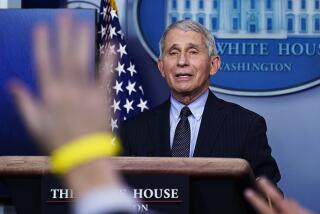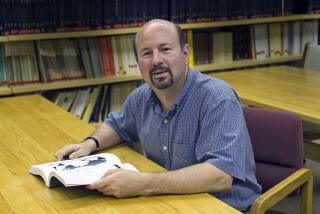RJR Lawyers Quashed Research, Memo Says
- Share via
Lawyers for R.J. Reynolds Tobacco Co. suppressed research on the hazards of smoking, including a company scientist’s discovery on how to remove carbon monoxide from cigarette smoke, according to an internal memo made public Wednesday.
The 1985 memo describes at length how scientists at RJR, the nation’s second-largest tobacco firm, were restricted by company lawyers on what they could study, what they could publish and how to communicate their findings, according to the previously secret memo that details how health research was subordinated to legal and regulatory concerns over a 30-year period.
The 104-page document, one of 39,000 made public by a congressional committee, provides an unusual window on a research and development enterprise that was under the heel of company lawyers who tried to beat back lawsuits and fend off regulation of the industry by the federal Food and Drug Administration.
According to the document, smoking and health research generally was not allowed to be done in-house, and outside projects and researchers were chosen by company lawyers--rather than members of the scientific staff.
Because the report was written by Reynolds’ primary outside law firm and is based on company documents and interviews with current and former RJR employees, it could provide potent ammunition in lawsuits accusing the industry of conspiring to suppress information about the dangers of their products.
This document and others also may have a significant impact on sweeping tobacco legislation now under consideration in Washington. “These documents paint an appalling and shocking picture,” particularly the role of industry lawyers in suppressing research into safer products and altering evidence of adverse health effects, Rep. Henry Waxman (D-Los Angeles) said.
RJR general counsel Charles Blixt countered by contending that the RJR memo did not reflect any inappropriate behavior.
“This is an industry that was in constant scrutiny over decades and was being sued by hundreds of lawyers around the country . . . ,” he said. “The issues that are reflected in here that lawyers might be interested in and involved in are exactly the issues you’d expect them to be involved in.”
President Clinton, in what has become a White House mantra each time embarrassing documents are disclosed, said the “release of these documents underscores the urgency of enacting comprehensive, bipartisan tobacco legislation this year, which can stop 3 million children from smoking over the next five years and save 1 million lives.”
The documents were released by Rep. Thomas J. Bliley (R-Va.), chairman of the House Commerce Committee, after the U.S. Supreme Court upheld the ruling of a Minnesota judge that the companies were not entitled to keep the materials confidential.
Attorneys for the state of Minnesota have introduced about a dozen of the documents so far in a case in which the state and Blue Cross/Blue Shield of Minnesota are suing the industry for $1.77 billion in damages.
The RJR memo reveals that as long ago as the mid-1950s, then-company President Edward Darr visited company scientist Alan Rodgman in his lab and said he was “somewhat perturbed” to find that Rodgman had isolated and confirmed the presence of benzopyrene, a carcinogen, in cigarette smoke.
Soon thereafter, however, Darr “made a speech in which he stated that [RJR] scientists had diligently searched for, but could not find, [benzopyrene] in cigarette,” the memo quotes Rodgman as saying.
At another point, the memo cites a handwritten note by Rodgman saying he “destroyed reports and letters for legal reasons.”
The document also describes what happened in 1953 when RJR scientist Claude Teague prepared a report on the large “volume of material which ‘indicted’ cigarette smoking” as a health hazard. According to Teague, company lawyers said the report should not be circulated.
The memo is the most detailed document ever disclosed that illustrates the critical influence of company lawyers--both in-house and outside counsel--on what scientists were permitted to study and what they could say about it. For example, one leading company lawyer told Reynolds’ scientists that they had to use the word “alleged” every time they referred to carcinogens.
By the time he became RJR’s research director in 1982, G. Robert Di Marco recalled that “the Company had given the responsibility of the Research Department in the area of smoking and health to the Law Dept. and it was understood that the lawyers controlled things in this area,” according to the memo.
The memo, prepared by Jones, Day, Reavis & Pogue, the Cleveland-based law firm that is RJR’s primary outside counsel, states that company scientists offered numerous examples of research they were not allowed to publish for fear it might be useful to tobacco foes.
For example, in the mid-1970s, RJR scientist John Reynolds discovered a method for removing carbon monoxide from cigarette smoke, but company lawyers declared that it could not be published. The scientist said later that he believed the decision was made because company lawyers feared that disclosure of the discovery would compel the company to adapt another process that, although safer, was potentially very expensive.
And the document describes the apparent suppression of research on how to filter out hazardous nitrosamines from cigarette smoke in the mid-1960s before a leading independent scientist published research on the topic.
The memo also describes instances of where research was done in Germany and retained there to keep it away from industry foes in this country.
The memo also describes an incident in which former RJR research chief Frank Colby pressured the publisher of a Tobacco Encyclopedia to drop an article by two leading smoking and health researchers and substitute one written by Colby himself. According to the memo, Colby said he told the publisher that many copies of the encyclopedia were purchased by tobacco companies and “publication of an ‘enemy’s’ article would not be well received.”
Normally, a company could keep documents of this kind confidential under the attorney-client privilege. But a Minnesota judge ruled this memo and thousands of others could be made public under an exception to normal legal rules that comes into play when there is evidence of crime or fraud. The companies unsuccessfully fought that ruling all the way to the U.S. Supreme Court.
On Wednesday, Minnesota Atty. Gen. Hubert H. Humphrey III said this document and others “make clear that the industry’s lawyers were an integral part” of a 40-year cover-up to suppress the health hazards of smoking. Nonetheless, RJR attorney Blixt continued to maintain Wednesday that the document “should have been privileged. It was developed by lawyers exclusively to attempt to develop defenses in litigation.”
It could take months before all the documents--180,000 pages--are thoroughly reviewed. The documents were posted on a congressional Web site--https://www.house.gov/commerce--but they were difficult to access, even for other House members and Senate staffers.
* IOWA RULING: Decision by state Supreme Court favors tobacco industry. D7
More to Read
Sign up for Essential California
The most important California stories and recommendations in your inbox every morning.
You may occasionally receive promotional content from the Los Angeles Times.













